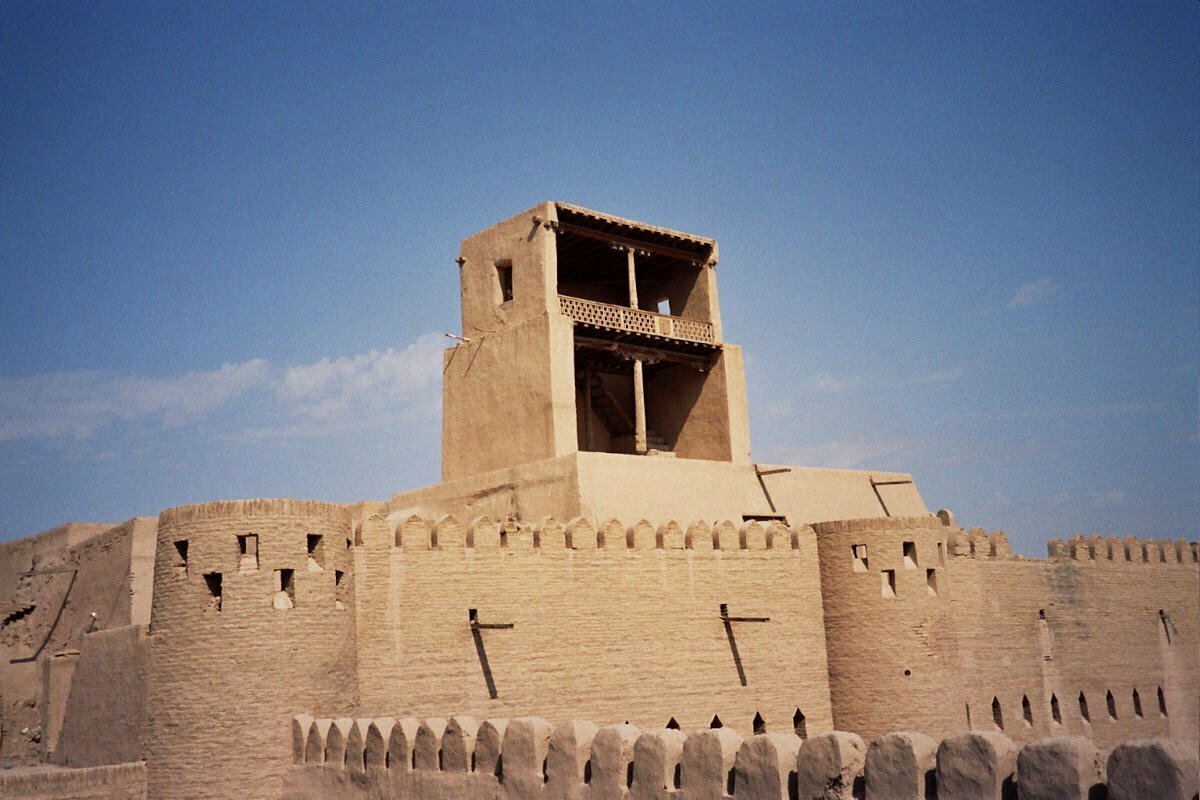Khiva - Citadel Kunya Ark
Kunya Ark is a historical citadel in the city of Khiva. The thickness of the cultural layers suggests that the area of the fortress (approx. 1 hectare) was inhabited for a long time. Most likely, it was the first construction that served as the beginning of the city’s foundation.

According to Abulgazikhan, there was no Ark citadel in Khiva in the 90s of the XVI century. It is also known that a new Kurinishkhona (reception) was built on this site in the time of Arangkhan (1686 – 1688).
The historic Kunya Ark citadel connects the western wall of Ichan-Kala with the residence of Ak-Sheikh Bobo in Khiva. In the late nineteenth century, Citadel Kunya Ark became a “city within a city” and was separated from Ichan-Kala by a high wall.
Citadel Kunya Ark was the former official residence of the Khiva Khan. It housed the chancellery, the arsenal, the mint, the mosque and the hall for receptions. It is a fortress, not a palace, surrounded by a high wall of mud bricks.
In the centre of this fortress is a religious structure – a tower of the legendary saint Ak Sheikh Bobo. It is separated from Ichan-Kala (historical centre of Khiva) by perfectly preserved mighty fortress walls. On the territory of the Kunya-Ark citadel there were the palace of the Khan of Khiva, winter and summer mosques, powder mill, mint, court, workshops, warehouses and other buildings.
Little remains of the construction of the citadel: both mosques, the mint, the building of the harem, the guardhouse at the east gate. The doors and balconies of the buildings are decorated with skilful wood carvings.
Of the khan’s palace, only the Kurinish-khona (room for receiving visitors) remains, consisting of the throne room and rooms for the archive of rare manuscripts and the khan’s treasury.
In the throne room, wooden columns on a carved marble base and majolica panels on the ceiling attract attention. The Summer Mosque also preserves the unique painted ceiling and majolica in relief on the walls.
The present Kunya Ark complex was restored in the early 19th century. The square near the entrance to the Kunya Ark was used for military parades and training battles.
There was also a special place for the execution of sentences and a zindan (prison) adjacent to the eastern walls of the Kunya Ark.
The mint has since been restored and its 19th century furnishings are recreated with mannequins of 19th century mint masters and a display of coins, silk and paper money.
Inside the harem’s two-storey building, visitors can expect luxurious interiors and living quarters. The Kunya Ark Citadel in Khiva is believed to have been built on the ruins of earlier structures.
During archaeological excavations, coins and ceramic fragments from the earlier historical period were found here. The first building of Kurinish-khona was built in 1686 – 1688 by Arang Khan and was rebuilt in the middle of the XVIIIth century, during the invasion of Iran. It was destroyed in the middle of the XVIII century during the Iranian invasion.
The modern building was constructed in 1804 – 1806 by Iltuzar-khan. Aiwan of Kurinish-khona was covered with majolica during the reign of Allakuli-Khan. Kurinish-khona consists of several rooms: open courtyard, aiwan, hall with throne and side rooms in the western part of the courtyard (khan’s treasury, room for storing manuscripts, rooms for recreation).
In the centre of the courtyard was a round elevation on which a yurt was erected, where the khan used to receive the ambassadors of his nomadic neighbours. The khan’s throne stood against the south wall of the throne room and is now in a museum in Moscow. It was made of wood and covered with silver plates with finely carved ornaments.
